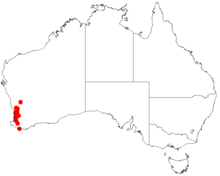Acacia oncinophylla
Acacia oncinophylla, commonly known as hook-leaved acacia,[1] is a shrub belonging to the genus Acacia and the subgenus Juliflorae.
| Hook-leaved acacia | |
|---|---|
| Scientific classification | |
| Kingdom: | Plantae |
| Clade: | Tracheophytes |
| Clade: | Angiosperms |
| Clade: | Eudicots |
| Clade: | Rosids |
| Order: | Fabales |
| Family: | Fabaceae |
| Clade: | Mimosoideae |
| Genus: | Acacia |
| Species: | A. oncinophylla |
| Binomial name | |
| Acacia oncinophylla | |
 | |
| Occurrence data from AVH | |
Description
The shrub typically grows to a height of 0.5 to 3 metres (2 to 10 ft)[2] and has minni ritchi style bark and flattened and angular ribbed branchlets that glabrous or sparsely hairy on ribs and are sometimes coated with a white powdery coating. Like most species of Acacia it has phyllodes rather than true leaves. Thee evergreen phyllodes have a linear or linear-oblanceolate shape and can be either straight or curved. The glabrous, flexible or semi-rigid phyllodes have a length of 4 to 13 cm (1.6 to 5.1 in) and a width of 1 to 6 mm (0.039 to 0.236 in) with an acute to acuminate apex and have three to seven raised nerves on each face.[1] It flowers from August to September producing yellow flowers.[2] The simple inflorescences are found in pairs in the axils and have cylindrical flower-spikes with a length of 11 to 25 mm (0.43 to 0.98 in) and a diameter of 5 to 6 mm (0.20 to 0.24 in) and are densley packed with 50 to 97 golden coloured flowers. After flowering golden to silver coloured velvety seed pods form that have a linear shape and are straight to very slightly curved. The pods have a length of up to 6 cm (2.4 in) and a width of 5 to 6 mm (0.20 to 0.24 in) with obliquely arrnaged seeds inside. The glossy black seeds have a broadly elliptic shape and a length of 3 to 3.5 mm (0.12 to 0.14 in) with an apical aril.[1]
Taxonomy
The species was first formally described by the botanist John Lindley in 1839.
There are two recognised subspecies:
- Acacia oncinophylla subsp. oncinophylla
- Acacia oncinophylla subsp. patulifolia
It is quite closely related to Acacia fauntleroyi which is found further the east.[1]
Distribution
It is native to Swan Coastal Plain and South West regions of Western Australia where it is commonly situated on hills andslopes growing in granitic or lateritic soils.[2] It is found from around Mogumber in the north and follow down the Darling Range to around Wagerup in the south often as a part of Jarrah woodland communities.[1]
See also
References
- "Acacia oncinophylla". World Wide Wattle. Western Australian Herbarium. Retrieved 7 December 2019.
- "Acacia oncinophylla". FloraBase. Western Australian Government Department of Parks and Wildlife.